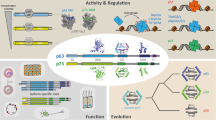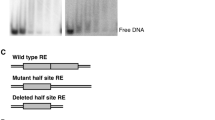Abstract
Recent experiments have suggested that p53 action may be mediated through its inter action with DNA. We have now identified 18 human genomic clones that bind to p53 in vitro. Precise mapping of the binding sequences within these clones revealed a consensus binding site with a striking internal symmetry, consisting of two copies of the 10 base pair motif 5′-PuPuPuC(A/T)(T/A)GPyPyPy-3′ separated by 0-13 base pairs. One copy of the motif was insufficient for binding, and subtle alterations of the motif, even when present in multiple copies, resulted in loss of affinity for p53. Mutants of p53, representing each of the four “hot spots” frequently altered in human cancers, failed to bind to the consensus dimer. These results define the DNA sequence elements with which p53 interacts in vitro and which may be important for p53 action in vivo.
This is a preview of subscription content, access via your institution
Access options
Subscribe to this journal
Receive 12 print issues and online access
$209.00 per year
only $17.42 per issue
Buy this article
- Purchase on Springer Link
- Instant access to full article PDF
Prices may be subject to local taxes which are calculated during checkout
Similar content being viewed by others
References
Vogelstein, B. Nature 348, 681–682 (1990).
Levine, A.J., Momand, J. & Finlay, C.A. Nature 351, 453–456 (1991).
Lane, D.P. & Benchimol, S. Genes Dev. 4, 1–8 (1990).
Michalovitz, D., Hatevy, O. & Oren, M. J. cell. Biochem. 45, 22–29 (1991).
Fearon, E.R. & Vogelstein, B. Cell 61, 759–767 (1990).
Kern, S.E. et al. Science 252, 1708–1711 (1991).
Bargonetti, J. et al. Cell 65, 1083–1091 (1991).
Fields, S. & Jang, S.K. Science 249, 1046–1049 (1990).
Raycroft, L., Wu, H. & Lozano, G. Science 249, 1049–1051 (1990).
Weintraub, H., Hauschka, S. & Tapscott, S.J. Proc. natn. Acad. Sci U.S.A. 88, 4570–4571 (1991).
Steinmeyer, K. & Deppert, W. Oncogene 3, 501–507 (1988).
Kern, S.E. et al. Oncogene 6, 131–136 (1991).
Kinzler, K.W. & Vogelstein, B. Nucleic Acids Res. 17, 3645–3653 (1989).
Kinzler, K.W. & Vogelstein, B. Molec. cell. Biol. 10, 634–642 (1990).
Nigro, J.M. et al. Nature 342, 705–708 (1989).
Hollstein, M., Sidransky, D., Vogelstein, B. & Harris, C.C. Science 253, 49–53 (1991).
Kraiss, S., Quaiser, A., Oren, M. & Montenarh, M.J. Virol. 62, 4737–4744 (1988).
Weinberg, R.A. Science 254, 1138–1146 (1991).
Friedman, P.N., Kem, S. E., Vogelstein, B. & Prives, C. Proc. natn. Acad. Sci. U.S.A. 87, 9275–9279 (1990).
McKay, R.D.G. J. molec. Biol. 145, 471–479 (1981).
Author information
Authors and Affiliations
Rights and permissions
About this article
Cite this article
El-Deiry, W., Kern, S., Pietenpol, J. et al. Definition of a consensus binding site for p53. Nat Genet 1, 45–49 (1992). https://doi.org/10.1038/ng0492-45
Received:
Accepted:
Issue Date:
DOI: https://doi.org/10.1038/ng0492-45
This article is cited by
-
PHLDA1 is a P53 target gene involved in P53-mediated cell apoptosis
Molecular and Cellular Biochemistry (2023)
-
p53 amyloid aggregation in cancer: function, mechanism, and therapy
Experimental Hematology & Oncology (2022)
-
abc4pwm: affinity based clustering for position weight matrices in applications of DNA sequence analysis
BMC Bioinformatics (2022)
-
Puf-A promotes cancer progression by interacting with nucleophosmin in nucleolus
Oncogene (2022)
-
p53 at the crossroad of DNA replication and ribosome biogenesis stress pathways
Cell Death & Differentiation (2022)



